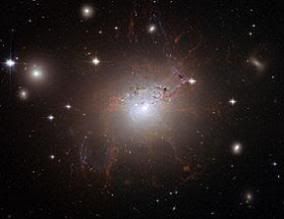Post by glactus on Jun 6, 2009 9:06:44 GMT

NGC 1275
How the strange shape of this seyfert 1 galaxy evolved nobody knows. But once again a collision between two galaxies is suspected, one of those a giant elliptic galaxy. NGC 1275 is the central galaxy of the Perseus Galaxy Cluster.
Constellation: Perseus
Distance: 230 million light-years
Visual magnitude: 12.48
Diameter: 100 000 light-years
Type: Ep
NGC 1275 consists of two galaxies, the central CD Galaxy and the so-called "high velocity system" (HVS) which lies in front of it. The HVS is moving at 3000 km/s towards the dominant system, and is believed to be merging with the Perseus Cluster.
The monster is also a well-known radio source (Perseus A) and a strong emitter of X-rays due to the presence of a black hole in the center of the galaxy.
This behemoth also lies at the center of the cluster of galaxies known as the Perseus Cluster. By combining multi-wavelength images into a single composite, the dynamics of the galaxy are more easily visible.
Detail and structure from x-ray, optical and radio wavelengths combine for an aesthetically pleasing, but nonetheless violent depiction of events going on at the heart of the galaxy.
Chandra data from the Advanced CCD Imaging Spectrometer covers X-ray energies and Hubble data from the Advanced Camera for Surveys covers optical wavelengths in the red, green and blue spectrums.
Radio data from NRAO's Very Large Array at 328 MHz was also used. In the composite image, the X-ray data contribute to the soft violet shells around the outside of the center.
The pinkish lobes toward the center of the galaxy are from radio frequencies, and tracing jets from the black hole, fills the X-ray cavities.
Dust lanes, star-forming regions, hydrogen filaments, foreground stars, and background galaxies are contributions from the Hubble optical data.
Credits: A Hubble Space Telescope image of NGC 1275.
HST/NASA/ESA/STScI/AURA.


